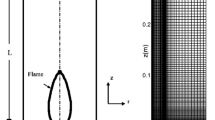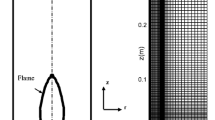Abstract
The transient behavior of flame in terms of temperature development and soot formation has been investigated numerically with an in-house developed code at normal gravity, reduced gravity of 0.5 G, and 0.0001 G (microgravity) in a methane air co flow laminar diffusion flame. The intermediate data of the field variables have been recorded at suitable intervals of time from ignition to convergence. Enhanced soot volume due to more residence time at lower gravity increases the radiative heat loss causing shrinkage of high temperature borne zone. Both soot volume and soot number register a build up and then a decay till steady state. The corresponding periods increase with the reduction of gravity. At microgravity, both the soot volume and soot particle number reach the peak at the same time and also almost stabilize concomitantly, unlike in other two gravity levels. The peak value of soot volume fraction, under 0.5 G and microgravity at steady state, become as high as 3.5 and 7 times respectively of the values at normal gravity due to surface growth. The soot number density, however, increases only 1.2 and 1.35 times respectively. The relatively lower factor of increase of soot number density is due to coagulation.

















Similar content being viewed by others
Abbreviations
- Cj :
-
Concentration of species.
- Djm :
-
Mass diffusivity.
- df :
-
Diameter of fuel tube.
- fv :
-
Soot volume fraction.
- g:
-
Acceleration due to gravity.
- h:
-
Enthalpy.
- k:
-
Absorption coefficient.
- Le:
-
Lewis number.
- n:
-
Soot number density.
- r:
-
Radial distance.
- \( \overline{R} \) :
-
Universal gas constant.
- t:
-
Time.
- v:
-
Velocity.
- Y:
-
Mole fraction.
- z:
-
Axial distance.
- ρ:
-
Density.
- \( \dot{\omega} \) :
-
Reaction rate.
- μ:
-
Viscosity.
- σ:
-
Stefan Boltzmann constant.
- λ:
-
Thermal conductivity.
References
Bhatia, P., Singh, R.: Effect of oxygen enrichment in propane laminar diffusion flames under microgravity and earth gravity conditions. Microgravity Sci. Technol. 29, 177–190 (2017)
Datta, A., Saha, A.: Contributions of self-absorption and soot on radiation heat transfer in a laminar methane-air diffusion flame. Proc. IMechE. 221, 955–970 (2006)
Ezekoye, O.A., Zhang, Z.: Soot oxidation and agglomeration modeling in a microgravity diffusion flame. Combust. Flame. 110, 127–139 (1997)
Heywood, J.B.: Internal Combustion Engine Fundamentals. McGraw-Hill, New York (1989)
Hirt, C.W., Cook, J.L.: Calculating three-dimensional flows around structures and over rough terrain. J. Comput. Phys. 10, 324–338 (1972)
Kaplan CR, Oran ES, Kailasanath K. Gravitational effects on Sooting diffusion flames. Twenty-sixth Symp. (Int.) Combust., Combust. Inst. 1301- 1309 (1996)
Kennedy, I.M.: Models of soot formation and oxidation. Prog. Energy Combust. Sci. 23, 95–132 (1997)
Kong, W., Liu, F.: Numerical study of the effects of gravity on soot formation in laminar coflow methane/air diffusion flames under different air stream velocities. Combust. Theory and Modelling. 13(6), 993–1023 (2009)
Kong, W., Liu, F.: Effects of gravity on soot formation in a Coflow laminar methane/air diffusion flame. Microgravity Sci. Technol. 22, 205–214 (2010)
Krikunova, A., Son, E.: Premixed flames under microgravity and Normal gravity conditions. Microgravity Sci. Technol. 30, 377–382 (2018). https://doi.org/10.1007/s12217-018-9607-8
Lee, K.B., Thring, M.W., Beer, J.M.: On the rate of combustion of soot in a laminar soot flame. Combust. Flame. 6, 137–145 (1962)
Ma, B., Cao, S., Giassi, D., Stocker, D.P., Takahashi, F., Bennett, B.A.V., Smooke, M.D., Long, M.B.: An experimental and computational study of soot formation in a coflow jet flame under microgravity and normal gravity. Proc. Combust. Inst. 35, 839–846 (2015)
Mandal BK, Sarkar A, Datta A. Transient development of flame and soot distribution in laminar diffusion flame with preheated air. ASME J. Engg. Gas Turb. Power., 131: 031501–1 031501–9 (2008)
Mitchell, R.E., Sarofim, A.F., Clomburg, A.: Experimental and numerical investigation of confined laminar diffusion flames. Combust. Flame. 37, 227–244 (1980)
Moss, J.B., Stewart, C.D., Young, K.J.: Modelling soot formation and burnout in a high temperature laminar diffusion flame burning under oxygen-enriched conditions. Combust. Flame. 101, 491–500 (1995)
Oh, C.B., Hamins, A., Bundy, M., Park, J.: The two-dimensional structure of low strain rate counterflow nonpremixed-methane flames in normal and microgravity. Combust. Theory and Modelling. 12(2), 283–302 (2008)
Patankar SV. Numerical heat transfer and fluid flow. Hemispherical Publishing Corporation. 1980
Reimann, J., Kuhlmann, A.S., Will, S.: Investigations on soot formation in Hepten jet diffusion flames by optical techniques. Microgravity Sci. Technol. 22, 499–505 (2010)
Santoro, R.J., Yeh, T.T., Horvath, J.J., Semerjian, H.G.: The transport and growth of soot particles in laminar diffusion flames. Combust. Sci. Technol. 53, 89–115 (1987)
Smooke, M.D., Mitchell, R.E., Keys, D.E.: Numerical solution of two-dimensional axisymmetric laminar diffusion flames. Combust. Sci. Technol. 67, 85–122 (1989)
Smooke, M.D., Mcenally, C.S., Pfefferle, L.D., Hall, R.J., Colket, M.B.: Computational and experimental study of soot formation in a coflow laminar diffusion flame. Combust. Flame. 117, 117–139 (1999)
Syed KJ, Stewart CD, Moss JD. Modelling soot formation and thermal radiation in buoyant turbulent diffusion flames. Proc. Twenty-Third Symp. (Int.) Combust., Combust. Inst., Pittsburgh.1533–1539 (1990)
Walsh, K.T., Fielding, J., Smooke, M.D., Long, M.B.: Experimental and computational study of temperature, species, and soot in buoyant and non-buoyant coflow laminar diffusion flames. Proc. Combust. Inst. 28, 1973–1979 (2000)
Zhang, Y., Liu, D., Li, S., Li, Y., Lou, C.: The influence of gravity levels on soot formation for the combustion of ethylene–air mixture. Russian J. Phys. Chem. A. 88(13), 2300–2307 (2014)
Author information
Authors and Affiliations
Corresponding author
Ethics declarations
Conflict of Interest
The authors declare that they have no conflict of interest.
Rights and permissions
About this article
Cite this article
Bhowal, A.J., Mandal, B.K. A Transient Study on the Development of Temperature Field and Soot under Reduced Gravity in a Methane Air Diffusion Flame. Microgravity Sci. Technol. 31, 13–29 (2019). https://doi.org/10.1007/s12217-018-9665-y
Received:
Accepted:
Published:
Issue Date:
DOI: https://doi.org/10.1007/s12217-018-9665-y




